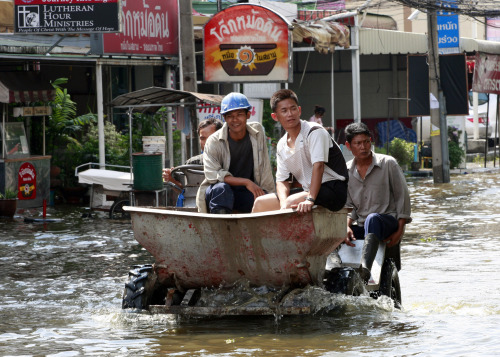Bangkokians are girding for the worst, though, after Prime Minister Yingluck Shinawatra this week urged all residents to move valuables to higher ground.
A mild panic prompted a run on grocery stores, with many running out of bottled water. A Thai company that distributes drinking water across the city sent out an SMS to customers announcing deliveries had been halted because of the crisis.
The government’s emergency relief center said flooding in the city was occuring at “concentrated points.” One of them, the northern district of Don Muang, was partially inundated after floodwaters burst through a canal barrier wall that workers were scrambling to repair overnight.
Don Muang is home to the capital’s second airport, as well as the government flood relief center. But some residents in swamped areas there said they were running short on food. Volunteers who had been preparing to send emergency supplies to Ayutthaya, a city north of Bangkok which has been submerged for more than two weeks, were forced to consume them instead.
“Now we’ve become flood victims” ourselves, said 53-year-old Pimnipha Na Bangchang. “We’re distributing this food aid to our community because we haven’t received any help.”
Also Saturday, Bangkok’s governor advised several thousand people living along the city’s main Chao Phraya river to move as high tides expected Sunday could cause the river to overflow its banks in some areas.
Excessive monsoon rains have drowned a third of the Southeast Asian nation since late July, causing billions of dollars in damage and putting nearly 700,000 people temporarily out of work.
Some flooding on Bangkok’s outskirts was expected after Yingluck ordered floodgates opened Thursday in a risky move to drain the dangerous runoff through urban canals and into the sea. Nobody knows with any certainty to what extent the city will flood.
In a weekly radio address Saturday, Yingluck said that “during the next four to six weeks, the water will recede.”
In the meantime, the government will step up aid to those whose lives have been disrupted, including 113,000 people living in temporary shelters after being forced to abandon submerged homes, she said.
The government said at least 356 people have died in the floods since July.
The flooding is the worst to hit the country since 1942, and the crisis is proving a major test for Yingluck’s nascent government, which took power in July after heated elections and has come under fire for not acting quickly or decisively enough to prevent major towns north of the capital from being ravaged by floodwaters.
The Labor Ministry says many of the nearly 700,000 people put temporarily out of work are from five major industrial estates north of Bangkok that were forced to suspend operations. Among those affected are Japanese carmakers Toyota and Honda, which have halted major assembly operations. The electronics industry has also suffered, including computer hard drive maker Western Digital, which has two major production facilities in the flooded zone.
In an interview published in the Bangkok Post, Science and Technology Minister Plodprasop Suraswadi said natural and manmade factors combined to create the crisis.
Seasonal monsoons came six weeks early and have lasted longer than usual, filling reservoirs, dams and fields with 30 percent more rainfall than average. At the same time, the government kept too much water in dams over the summer in a bid to save water for rice cultivation, Plodprasop said.
Overall, about 700 billion cubic feet (20 billion cubic meters) of rainfall has drenched Thailand over the last several months, Plodprasop said.
About half of that has already drained into the sea, leaving about 350 billion cubic feet (10 billion cubic meters) of water threatening Bangkok, much of it spread across rice fields in Thailand’s central plains.
Plodprasop said it will take about 20 more days to drain those floodwaters into the Gulf of Thailand, a task he said was complicated by the fact that the nation’s irrigation system was designed to control water flows for farming and consumption -- not to prevent floods.
“We have never faced such a huge mass of floodwater in the fields,” Plodprasop said.
He said he believed inner Bangkok “should be safe, as we have an extensive drainage system with water pumps to drain excess water out quickly.” But some of the city’s outskirts could flood up to 6 feet (2 meters) deep, he said.
<한글 기사>
태국, 비는 그쳤지만 6주간 침수 왜?
수십 년만에 최악의 물난리를 겪고 있는 태국에 앞으로도 길게는 6주간 침수 상태가 계속될 수 있다고 잉락 친나왓 총리가 22일 경고했다.
잉락 총리는 이날 연설에서 홍수가 4~6주간 더 계속될 수 있다며 침수에 대비해 차량과 물품을 높은 곳에 올려놓으라고 방콕 주민에게 당부했다.
잉락 총리는 “물을 빼기 위해 방콕의 모든 수문을 개방해야 한다”며 “따라서 시 민들은 차량과 가재도구, 귀중품을 지상 1m 이상 높이로 옮겨야 한다”고 말했다.
태국 정부는 방콕 시내 배수관을 통해 중부 평야지대의 물을 바다로 빼내는 작업에 착수했다.
이번 홍수로 방콕 북부 외곽 지역에는 물이 허리 높이까지 차올라 있으며 저지대 주민 11만3천명에게 대피령이 내려졌다.








